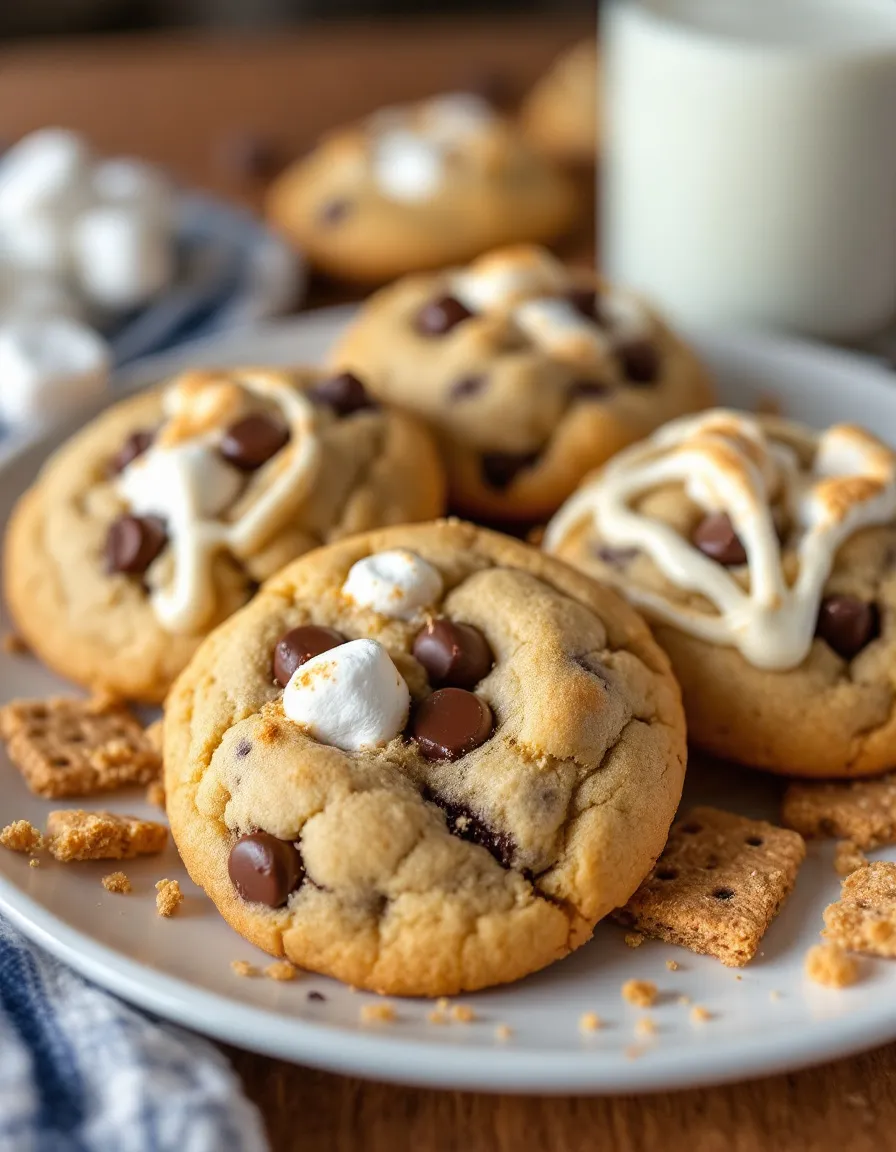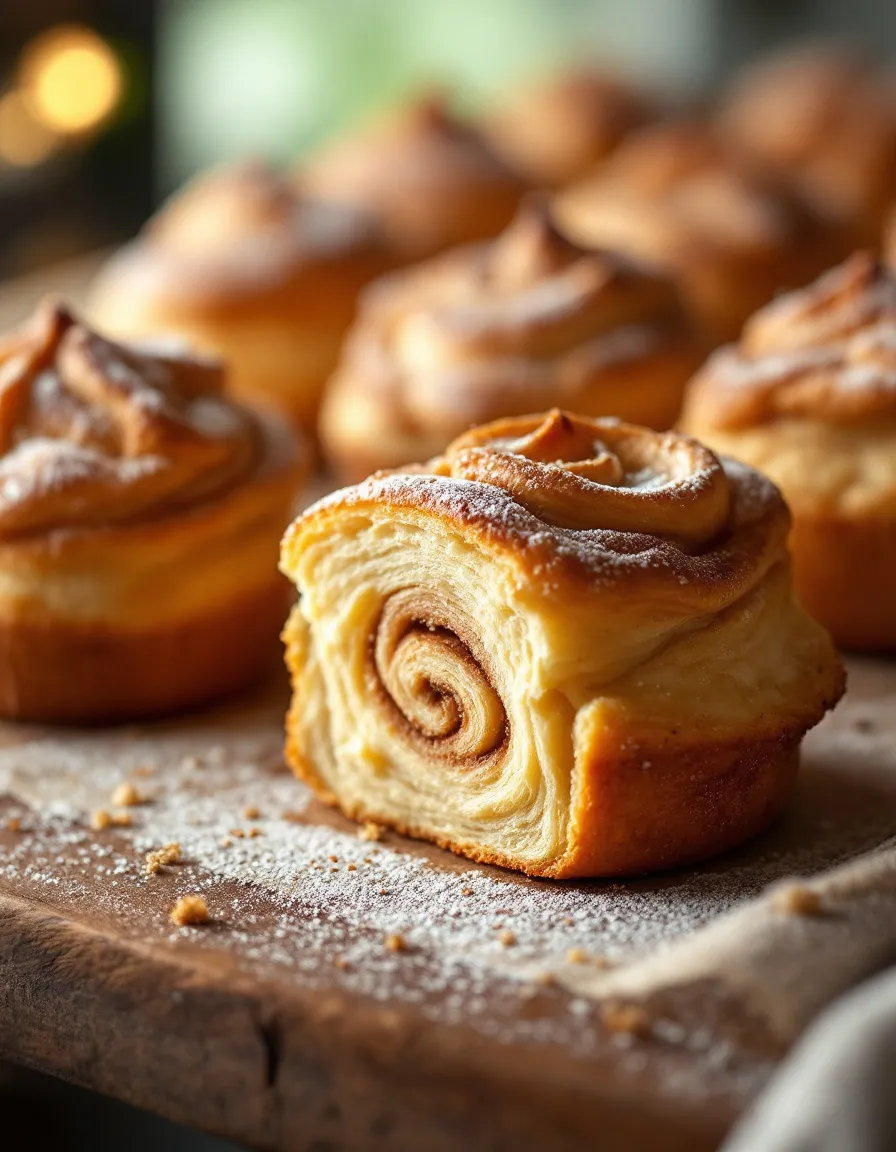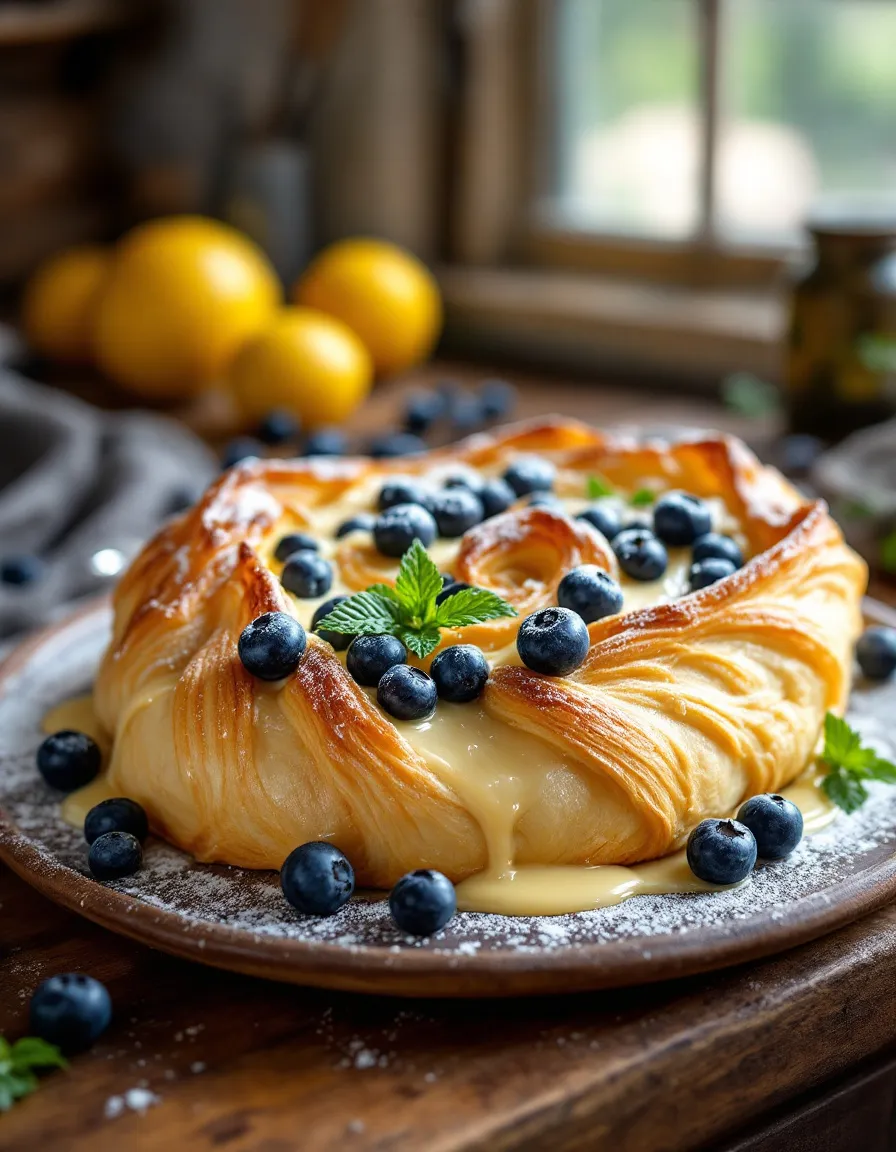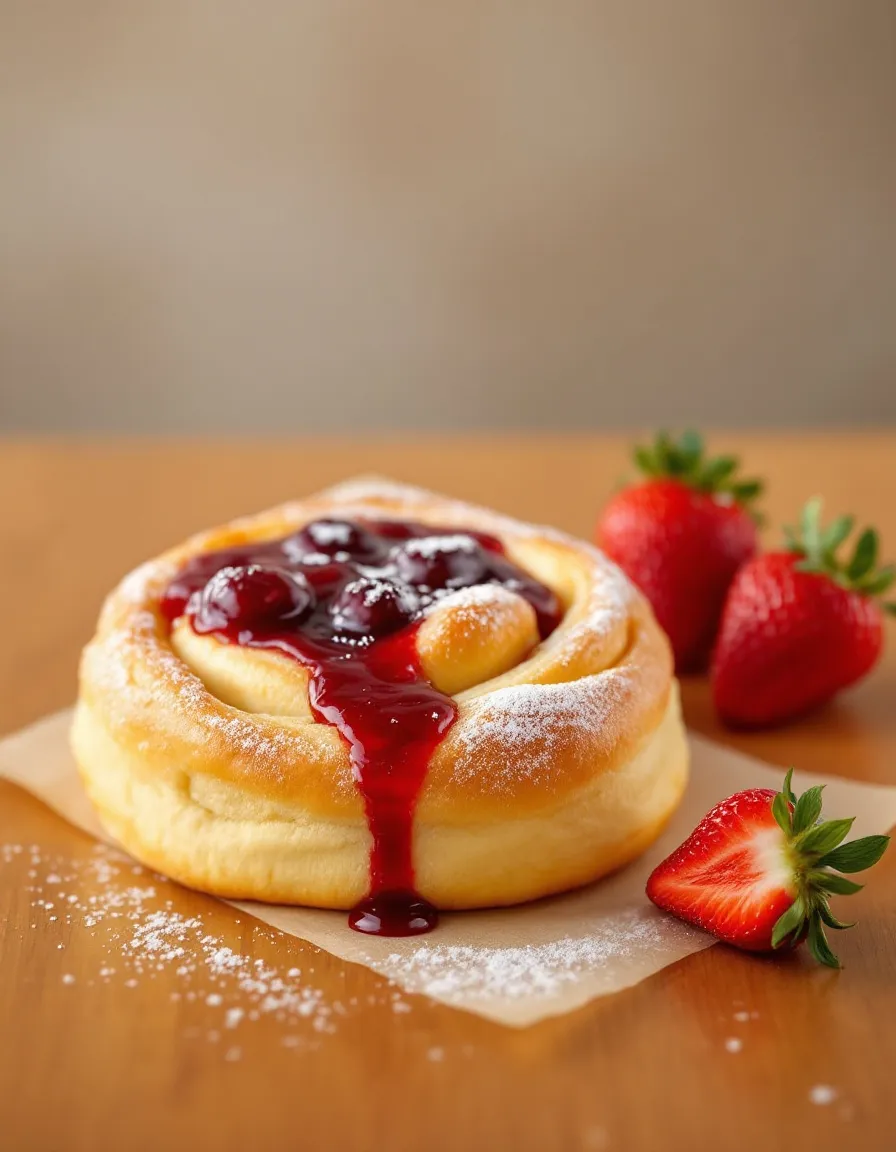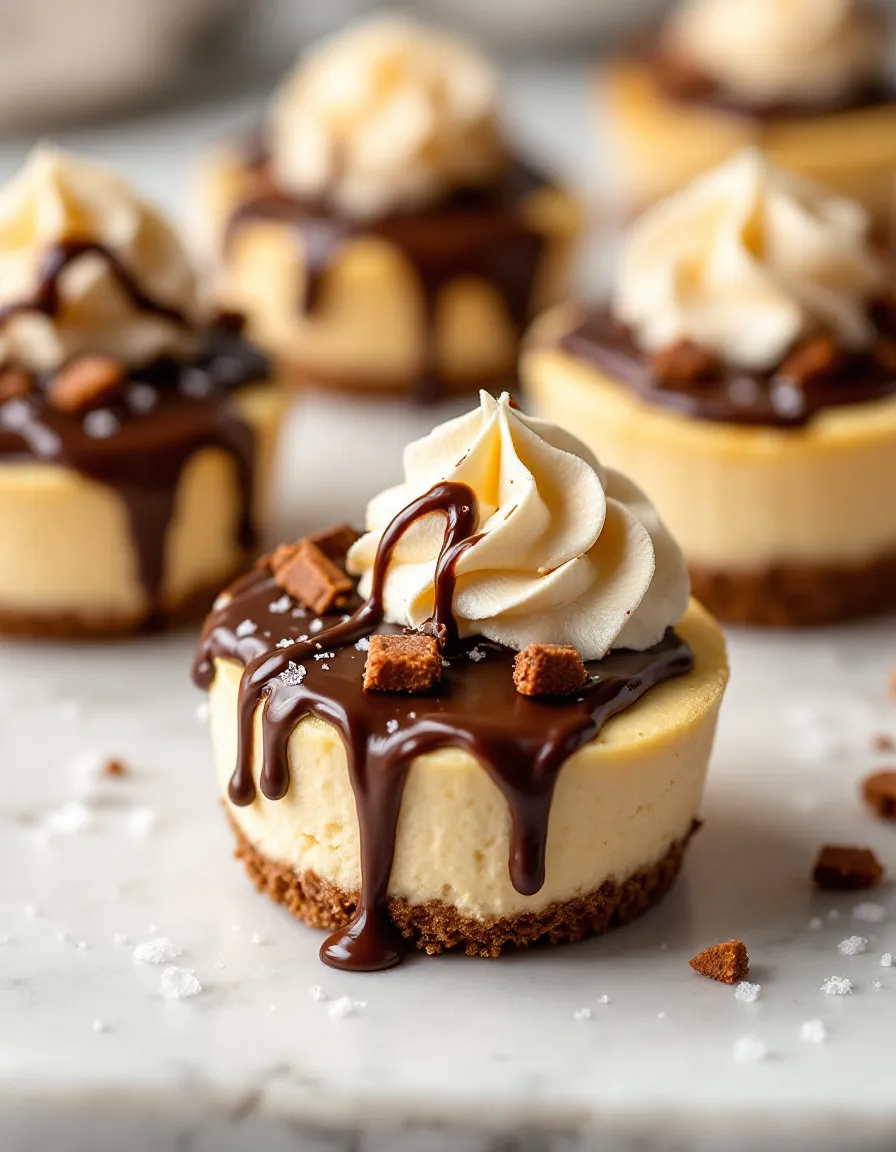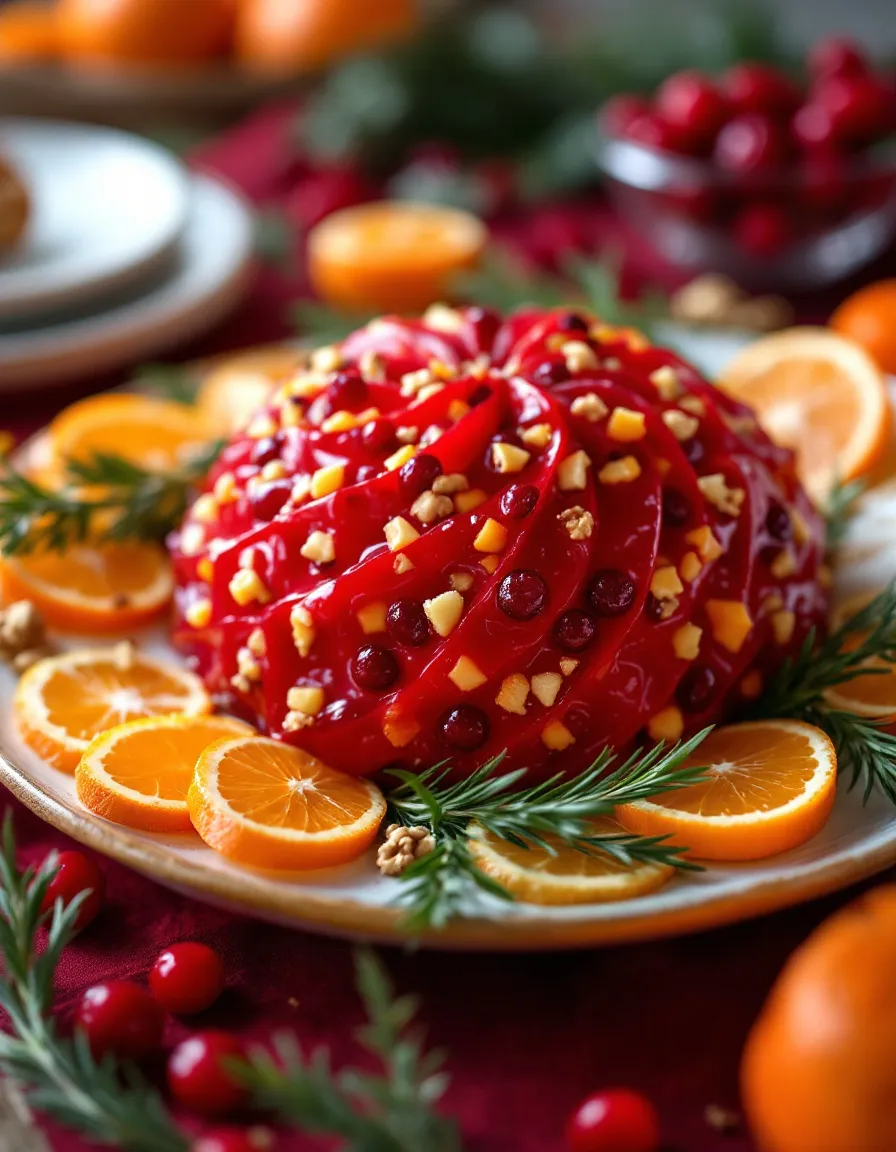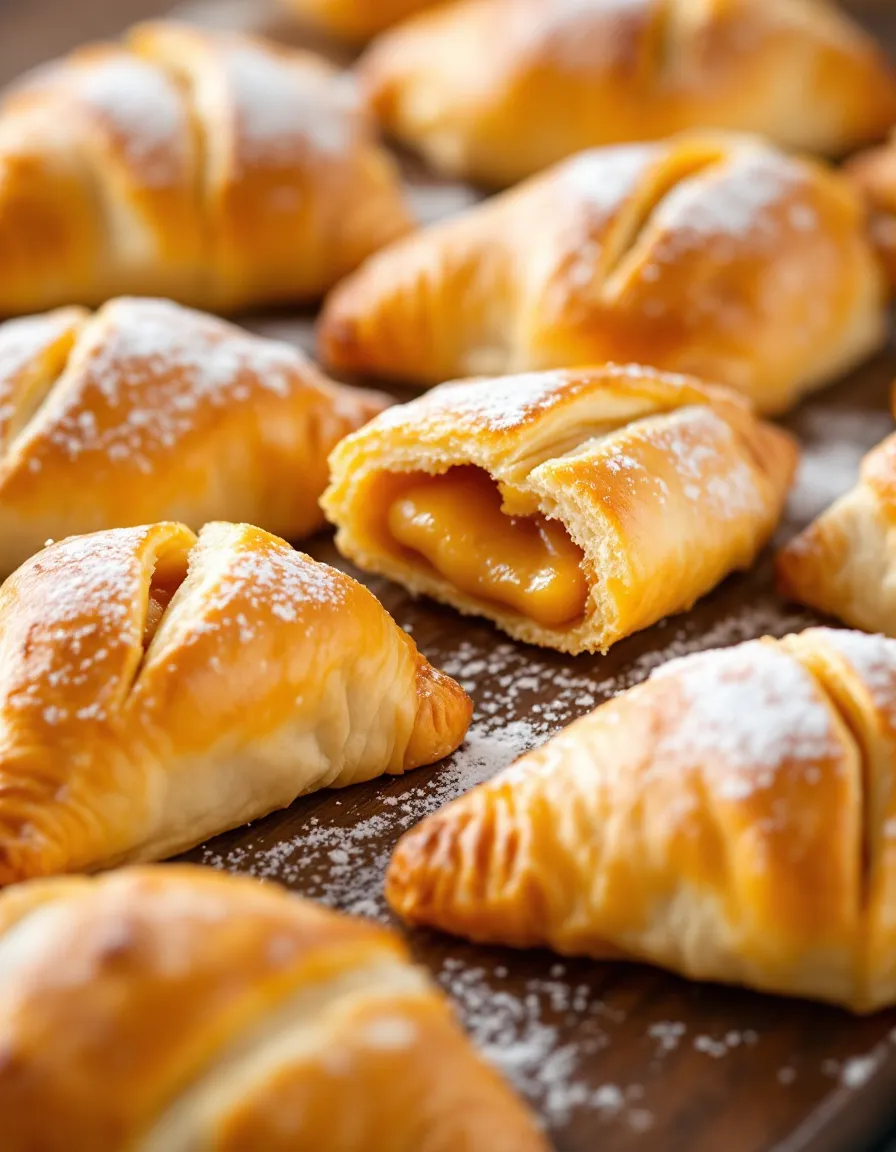S’mores Chocolate Chip Cookies: A Delicious Twist on a Classic Treat
If you’re looking for a dessert that beautifully combines nostalgia with modern flavors, these S’mores Chocolate Chip Cookies are your answer. Imagine biting into a perfectly baked cookie that oozes melted chocolate while the graham cracker bits add a subtle crunch, mimicking the campfire favorite s’mores. The marriage of these flavors evokes warm memories of summer nights spent around the fire, making this treat perfect for any occasion, whether a cozy family gathering or a festive party with friends.
These S’mores Chocolate Chip Cookies bring comfort and joy in every bite. The gooeyness of the chocolate chips pairs perfectly with the soft, chewy texture of the cookie, while the marshmallows add a delightful sweetness that complements the rich, buttery flavor. Each cookie is a delightful fusion of textures — soft, chewy, and slightly crispy around the edges, creating a symphony of flavors that both kids and adults will love. Once you bite into them, you’ll find it hard to stop at just one!
Quick Recipe Highlights
- Flavor Profile: These cookies feature a delightful mix of milk chocolate and graham cracker with hints of vanilla that perfectly embodies the classic s’mores experience.
- Texture: The soft and chewy interior offers a wonderful contrast to the slightly crispy edges, with gooey marshmallows and crunchy chocolate bits throughout.
- Aroma: The warm aroma of baked cookies combined with the sweet scent of melted chocolate and toasted marshmallows fills your kitchen with an inviting allure.
- Visual Appeal: Golden brown cookies dotted with melty chocolate chunks and flecks of crushed graham crackers provide an enticing visual experience that is sure to please the eye.
- Skill Level Needed: With a bit of mixing and measuring, this recipe is perfect for all skill levels, making it accessible to novice bakers and experienced chefs alike.
- Special Equipment: No special equipment is required for this recipe, just a mixing bowl, a baking sheet, and a good spatula!
Recipe Overview
- Difficulty Level: These cookies are classified as medium difficulty as they require basic baking skills and a few simple techniques, making them perfect for both beginners and more seasoned bakers.
- Category: This recipe fits perfectly in the dessert category and is ideal for satisfying sweet cravings as a snack or at the end of a meal.
- Cuisine: Influenced by American traditions, the s’mores flavor resonates with summer camp experiences and outdoor adventures, making these cookies a nostalgic favorite.
- Cost: The ingredients for this cookie recipe are budget-friendly, costing around $10 total, making it an economical choice for a sweet treat.
- Season: While s’mores are often associated with summer, these cookies can brighten any season, bringing warmth and sweetness even during winter months.
- Occasion: Perfect for birthday parties, family gatherings, or cozy nights in, these cookies can elevate any occasion and are sure to impress guests.
Why You’ll Love This Recipe
The blend of chocolate and graham cracker in these S’mores Chocolate Chip Cookies creates an indulgent treat that satisfies your sweet tooth while delivering the nostalgia of traditional s’mores. The textures play a significant role as well; the soft, chewy cookies contrasted with the crunchy chocolate chips and gooey marshmallows make every bite an exciting experience. You won’t just taste the ingredients; you’ll evoke memories of camping trips and warm campfires, making them perfect for any occasion.
Preparation is a breeze with this recipe, allowing you to whip up a batch in no time. With just a few simple steps, even novice bakers will find success, making it a great choice for baking with kids or friends. Plus, the combination of familiar ingredients means you likely have most at home already, minimizing the need for special shopping trips.
These S’mores Chocolate Chip Cookies are not only a treat for the palate, but they also carry nutritional benefits. Using quality chocolate can provide antioxidants, while oats from crushed graham crackers add a touch of fiber. These cookies can serve as an occasional indulgence that can fit into a balanced diet when enjoyed in moderation.
Serving guests these delightful cookies can spark conversations and create a fun atmosphere. Their eye-catching appearance and familiar flavors make them a hit at gatherings. Whether you’re hosting a potluck or simply having friends over, these S’mores cookies are bound to be a crowd-pleaser, creating lasting memories associated with good food and company.
Cost-effective and accessible, making these cookies is an investment in happiness. With minimal ingredients and preparation time, they’re ideal for spontaneous baking sessions or when you need a quick dessert. Plus, any extras can be easily stored, ensuring that the sweet treats last for several days, making them a delightful option to satisfy late-night cravings or unexpected guests.
Historical Background and Cultural Significance
S’mores, a beloved American campfire treat, trace their origins back to the 1920s when Girl Scouts were known to concoct the combination of chocolate, marshmallows, and graham crackers. The phrase “some more” was eventually shortened to “s’mores,” reflecting the insatiable desire to keep enjoying more of these sweet delights. These cookies honor the traditional flavor combination while providing a new spin that allows us to experience the classic flavors in a fresh format.
The cultural significance of s’mores stretches beyond just a tasty treat; they symbolize camaraderie and sharing moments around a fire. This collective experience of roasting marshmallows and assembling s’mores fosters community and connection, making them a cherished feature at campsites, picnics, and beach bonfires. By transforming this experience into cookie form, these S’mores Chocolate Chip Cookies allow you to savor that nostalgia anywhere at any time.
As with many timeless recipes, adaptations and evolutions have occurred, particularly as s’mores gained popularity. In addition to traditional flavorings, you might now find variations featuring different types of chocolates, flavored marshmallows, or even unique toppings that pay homage to local ingredients, like peanut butter or coconut. Each variation adds a layer of personal preference while continuing to celebrate that classic chewy and crispy s’mores experience.
Regional variations of s’mores have emerged that reflect local tastes and traditions. In places like the Pacific Northwest, adding sea salt or local berries transforms the classic cookie into a gourmet treat. Some regions even embrace international influences by incorporating ingredients like dulce de leche or caramel, showcasing the evolution and creativity inherent in merging traditional recipes with modern flair.
Ingredient Deep Dive
Chocolate Chips
Chocolate chips are not just a tasty morsel; they bring richness and sweetness unparalleled in desserts. Originating in the United States in the 1930s, chocolate chips add a layer of texture and can be found in a plethora of desserts, making them a dessert pantry staple. Nutritionally, their antioxidant properties contribute to overall health when consumed in moderation.
When selecting chocolate chips, choose high-quality options with the cocoa content you prefer. Dark chocolate adds a rich taste while semi-sweet chips provide a more balanced sweetness. Store chocolate chips in a cool, dry place; they can easily last for several months. In a pinch, consider substituting with chopped chocolate bars or cocoa nibs, which can elevate the flavor profile.
Marshmallows
Marshmallows are the quintessential ingredient that gives s’mores their beloved sticky sweetness. While their origins date back to ancient Egypt, modern marshmallows are made primarily from sugar, water, and gelatin. They contribute a chewy texture and sweet flavor that complements chocolate remarkably well.
Choosing the right marshmallow is key; opt for fresh, high-quality marshmallows for better results. Store them in a cool, airtight container to maintain their fluffiness. If desired, you can swap them with vegan marshmallows or use homemade ones for a touch of personalization.
Graham Crackers
Graham crackers are a foundational component of the s’mores experience. Originally developed in the early 19th century by Sylvester Graham, these crackers were intended for a healthier lifestyle. Their unique, slightly sweet flavor and crunchy texture make them perfect for dessert applications.
When selecting graham crackers, look for whole-grain options for added nutrition. Store them in an airtight container to maintain freshness, and consider using crushed graham crackers for an alternative texture. If you’re looking for gluten-free options, many brands now offer gluten-free graham crackers that can be used interchangeably in this recipe.
Common Mistakes to Avoid
- Overmixing the dough can lead to tough cookies. Mixing just until combined ensures a tender texture.
- Not chilling the dough may result in cookies that spread too much during baking. A brief chill in the fridge allows for better shape retention.
- Using stale chocolate chips or graham crackers can affect flavor. Always use fresh ingredients for the best results.
- Skipping the parchment paper can lead to cookies sticking to the pan and uneven baking. Always line your baking sheet for easy removal.
- Not preheating your oven could result in uneven baking. Allow sufficient time for the oven to reach the desired temperature.
- Not testing cookie doneness may yield overcooked or undercooked cookies. Use the recommended bake time and check for slight browning around the edges.
- Neglecting to measure ingredients accurately can lead to inconsistent texture. Use measuring cups and spoons to ensure precision.
- Using a baking sheet that’s too small can lead to overcrowding. Space cookies evenly on the sheet for proper baking.
- Ignoring cooling time can result in broken cookies. Let cookies cool as instructed to firm up before transferring.
- Forgetting to sprinkle sea salt on top can limit flavor depth. A pinch of salt enhances sweetness and balances the flavors.
Essential Techniques
Mixing Cookie Dough
The method by which you mix your cookie dough is crucial for achieving the desired texture. Begin by creaming the butter and sugars until light and fluffy, which incorporates air and dissolves sugar for a tender cookie. Be careful not to overmix after adding the flour, as this can lead to tough cookies. Look for visual cues: the dough should be well combined with no patches of flour visible, yet still slightly soft and sticky.
Chilling the Dough
Chilling the dough is an often overlooked technique that improves cookies’ texture. Cold dough spreads less, resulting in thicker cookies with a chewy center and crisp edges. To chill, wrap the dough in plastic wrap and refrigerate for at least 30 minutes. Common pitfalls include skipping this step or rushing it; be patient for the best results! A well-chilled dough should be firm to the touch but still pliable.
Pro Tips for Perfect S’mores Chocolate Chip Cookies
1. Experiment with flavored chocolate chips such as peanut butter or white chocolate to create unique variations that enhance the s’mores experience.
2. For an extra gooey texture, add some marshmallow fluff into the dough before baking.
3. Use a cookie scoop for even-sized cookies that bake uniformly.
4. Add chopped nuts like pecans or walnuts for a crunchy contrast and nutty flavor.
5. To enhance the flavor, try using browned butter instead of regular butter; the nutty undertones will elevate your cookies.
6. After baking, top warm cookies with an additional chocolate piece to amplify the chocolate flavor and presentation.
7. For an extra boost of flavor, consider adding a teaspoon of vanilla extract or even a pinch of cinnamon to the dough.
8. Always let cookies cool on the baking sheet for a few minutes before transferring them to a wire rack to ensure they don’t break apart.
Variations and Adaptations
Regional variations of s’mores cookies can include unique additions like almond butter or coconut to reflect local tastes. Seasonal adaptations might introduce pumpkin spice or peppermint for that festive flair, especially around the holidays. Dietary modifications allow for gluten-free options like almond flour in place of regular flour, and vegan alternatives can include flax eggs and dairy-free chocolate chips for a guilt-free treat.
Flavor variations can lead you to mix in butterscotch chips or peanut butter for additional sweetness and complexity. Texture modifications could include using oatmeal for chewiness or adding crispy rice cereal for that delightful crunch. As for presentation, consider drizzling with melted chocolate or sprinkling additional graham cracker crumbs on top for a stunning finish.
Serving and Presentation Guide
When serving your S’mores Chocolate Chip Cookies, consider using decorative plates to amplify visual appeal. Adding a simple garnish such as a sprig of mint or a dusting of confectioner’s sugar can make a refined touch. Cookies can also be presented in a rustic cookie jar or on a wooden cutting board for a homely feel.
For an upscale twist, serve your cookies alongside a scoop of ice cream or with a homemade chocolate sauce for dipping. When considering portion sizes, aim for cookies that are about the size of your palm; this ensures a satisfying treat without going overboard. Keep in mind that temperature can influence enjoyment — serving them warm straight from the oven or lightly heated gives them a delightful gooey texture.
Wine and Beverage Pairing
Pairing your S’mores Chocolate Chip Cookies with beverages can enhance the overall experience. Consider rich dessert wines like port or a sweet dessert wine such as Moscato, which complement the cookies’ sweetness beautifully. For a more classic pairing, a cold glass of milk is a timeless choice that balances the richness of chocolate.
Non-alcoholic alternatives include coffee or a hot chocolate with a hint of peppermint for a festive twist. If you enjoy iced beverages, an iced latte can provide a refreshing contrast to the cookies’ sweetness while enhancing the chocolate flavors. Always serve these drinks at the appropriate temperature: cold drinks chilled and hot drinks steaming to fully enjoy the flavors.
Storage and Shelf Life
To keep your S’mores Chocolate Chip Cookies fresh, store them in an airtight container at room temperature. They can last for about a week before they start losing their fresh and chewy texture. For optimal freshness, you might consider freezing individual cookies; they should be wrapped in plastic wrap and placed in a freezer-safe bag, where they can last up to three months.
Signs of spoilage include changes in texture or off-smells. For best results, you can reheat them for a few seconds in the microwave to restore their chewy goodness. When freezing, remember to allow cookies to cool completely before wrapping to prevent condensation and freezer burn.
Make Ahead Strategies
For busy bakers, preparing S’mores Chocolate Chip Cookies ahead of time is ideal. You can make the dough in advance and chill it in the refrigerator for up to 48 hours. This allows you to bake fresh cookies at any moment without a long prep time.
When making ahead, remember to allow the dough to warm slightly before scooping it onto baking sheets to ensure even baking. Additionally, consider baking a large batch and freezing some so you can pull out a few cookies when unexpected guests arrive or you’re craving a late-night treat. Assembling fresh elements like marshmallows or chocolate on top just before baking can ensure they taste freshly made.
Scaling Instructions
If you want to make a smaller batch of S’mores Chocolate Chip Cookies, simply halve the ingredient amounts. This adjustment can be helpful when baking for fewer people or if you’re just trying them out for the first time.
For larger gatherings, consider doubling or tripling the recipe, ensuring you have ample baking sheets and adequate cooling space. Baking time may slightly vary with larger batches; always consult visual cues to determine doneness. For storage, remember to keep any uneaten cookies in separate containers to retain freshness.
Nutritional Deep Dive
In each S’mores Chocolate Chip Cookie, you’ll find a balance of macronutrients that satisfies your sweet cravings. Each cookie typically contains around 150 calories, with fats coming primarily from butter and chocolate. Protein content is modest, at around 2-3 grams per cookie, while carbohydrates mainly come from sugars and flour.
Micronutrient analysis shows that cookies can offer minimal amounts of important vitamins and minerals such as calcium from milk chocolate, iron from enriched flour, and dietary fiber from graham crackers. While they’re indulgent treats, enjoying them occasionally can fit within a balanced diet, particularly if paired with healthier meals throughout your day.
Dietary Adaptations
Making S’mores Chocolate Chip Cookies suitable for gluten-free individuals is straightforward. Using gluten-free flour, combined with the same ratios of ingredients, can yield delightful results. For those who are dairy-free, substitute butter with coconut oil or a vegan butter alternative, and use dairy-free chocolate chips to maintain flavor integrity.
For vegan versions, consider using flaxseed eggs or applesauce in place of eggs while ensuring the chocolate and marshmallows are plant-based. If you’re following a low-carb or keto diet, almond flour and sugar substitutes like erythritol can make for a reduced-carb alternative, allowing enjoyment without compromising dietary goals.
Troubleshooting Guide
If your cookies turn out too dry, check your ingredient measurements. Too much flour can lead to dryness, so ensure accuracy next time. Conversely, if the cookies are too gooey, it may be a sign to adjust the baking time or oven temperature, as underbaking can lead to overly soft centers.
Flavor balance can sometimes be an issue if the mixture lacks salt; a pinch can enhance sweetness and overall flavor. If you notice spreading while baking, consider chilling the dough longer, which can help maintain shape. Be mindful of oven calibration as a temperature discrepancy can result in inconsistent baking; using an oven thermometer can help ensure accurate temperatures.
Recipe Success Stories
Readers rave about the culinary magic these S’mores Chocolate Chip Cookies create. Community feedback highlights the delightful flavors and textures that mirror the classic campfire treat. Many have shared their adaptations, from adding peanut butter chips to experimenting with various types of chocolate, resulting in a tapestry of flavors!
Those who have baked these cookies often send in photos showcasing their creations, and it’s wonderful to see the variations and artistic presentations. Each baking story champions a love for sharing and experimenting, showcasing how versatile a simple cookie can be and sparking inspiration in home bakers everywhere.
Frequently Asked Questions
Can I use whole wheat flour instead of all-purpose flour?
Absolutely! Whole wheat flour will add a nuttier flavor and additional nutrients. Just note that it may alter the texture slightly, making it denser.
How do I keep the cookies from becoming too dry?
Ensure you’re accurately measuring your ingredients, particularly flour. Adding a tablespoon or two of milk can also help keep the cookies moist if the dough seems dry.
Can I freeze the cookie dough?
Yes! You can freeze the dough for up to three months. Just scoop the dough onto a baking sheet and freeze, then transfer to a freezer-safe bag. Bake directly from frozen, adding a couple of extra minutes to the baking time.
What should I do if my cookies spread too much while baking?
This might happen due to warm dough; chilling before baking can prevent excessive spreading. Alternatively, ensure your oven is fully preheated before baking to help them set quickly.
Can I substitute chocolate chips with something else?
Sure! You can replace chocolate chips with white chocolate or butterscotch chips, nuts, or even chopped chocolate bars for different flavor profiles.
How do I know when the cookies are done baking?
Look for slightly golden edges and a soft but set center. They will continue to firm up as they cool, so pull them from the oven when they still look a touch underbaked.
Can I make these cookies vegan?
Yes! Substitute the eggs with flax eggs and use dairy-free chocolate chips and vegan butter to make a delicious vegan version of these cookies.
What’s the best way to store leftover cookies?
Store them in an airtight container at room temperature for up to a week or freeze them for longer storage to maintain their deliciousness.
Can I add fruit to the cookies?
While it’s not traditional, adding dried fruit like cranberries or cherries can lend a nice tartness that complements the sweetness of the s’mores theme!
Are there any gluten-free options for this recipe?
Yes! You can use gluten-free flour blends that are designed for baking. Just make sure to follow the recommended measurements on the package for best results.
Additional Resources
If you loved these S’mores Chocolate Chip Cookies, you might enjoy other dessert recipes that evoke similar flavors, such as brownies or chocolate lava cakes. Technique guides in cookie baking can enhance your skills, featuring tips on glazing or decorating cookies for special occasions.
Explore ingredient information for chocolate varieties or tips on choosing the best marshmallows to ensure your treats are delightful every time. Also, explore seasonal variations such as summer treats or winter delights to keep your baking exciting year-round!
Join the Conversation
We’d love to hear about your experiences with these S’mores Chocolate Chip Cookies! Share your photos, variations, and feedback on social media to inspire fellow bakers. Engaging in recipe reviews and exchanges helps strengthen our community, and we encourage you to explore creative adaptations that resonate with your taste!
From tips for capturing perfect cookie photos to story-sharing about your s’mores baking adventures, participating in the conversation enriches our culinary journey. Let’s create cookies that not only taste good but bring us together!
The Recipe
S’mores Chocolate Chip Cookies
Serves: 24 cookies
Prep Time: 15 mins
Cook Time: 12 mins
Total Time: 27 mins
Kitchen Equipment Needed
- Baking Sheet
- Mixing Bowls
- Electric Mixer
- Parchment Paper
- Cookie Scoop
Ingredients
- 1 cup unsalted butter, softened
- 3/4 cup brown sugar, packed
- 3/4 cup granulated sugar
- 2 large eggs
- 2 teaspoons vanilla extract
- 2 1/4 cups all-purpose flour
- 1 teaspoon baking soda
- 1/2 teaspoon salt
- 1 cup chocolate chips
- 1 cup marshmallows, halved
- 1 cup crushed graham crackers
Directions
- Preheat your oven to 350°F (175°C) and line a baking sheet with parchment paper.
- In a large bowl, cream together the softened butter, brown sugar, and granulated sugar until light and fluffy.
- Add in the eggs one at a time, mixing well after each addition, followed by the vanilla extract until combined.
- In a separate bowl, whisk together the flour, baking soda, and salt.
- Gradually add the dry ingredients to the wet ingredients, mixing just until combined.
- Fold in the chocolate chips, marshmallows, and crushed graham crackers until evenly distributed throughout the dough.
- Using a cookie scoop, drop dough onto the prepared baking sheet, spacing them 2 inches apart.
- Bake cookies for 10-12 minutes or until golden brown around the edges.
- Allow cookies to cool on the baking sheet for a few minutes before transferring them to a wire rack to cool completely.
Recipe Notes
- For extra flavor, try adding a sprinkle of sea salt on top before baking.
- Feel free to experiment with different types of chocolate chips for a unique taste.
- Store leftover cookies in an airtight container for up to a week.
- You can freeze the dough to bake fresh cookies later.
